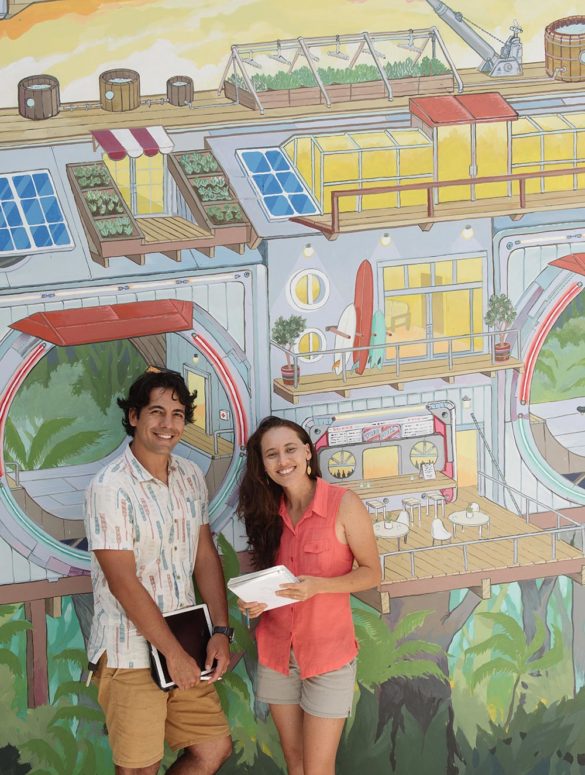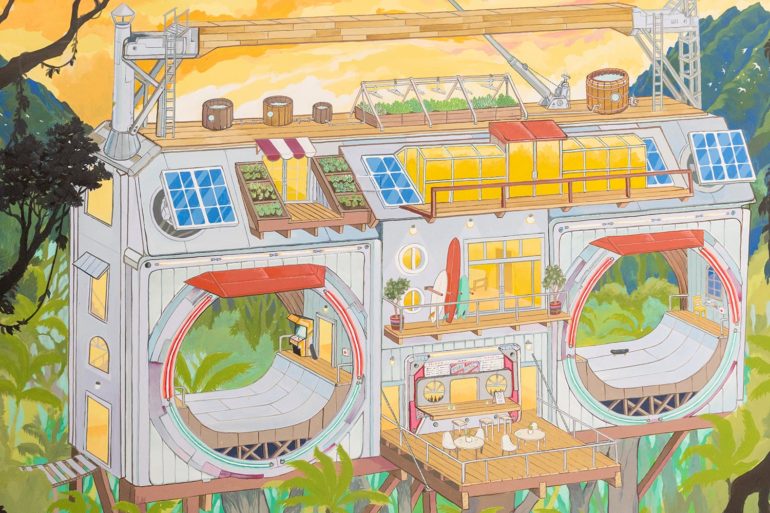In a stairwell off the rooftop pool deck at ‘Alohilani Resort, an unusual image awaits: a giant boombox nestled in a forest, held aloft by wooden stilts and tree trunks. Judging by how it towers over the swaying palms underneath, this isn’t a typical boombox. In place of dials, there are water catchment tanks that feed into a rooftop greenhouse. The cassette player has been reimagined as a café, complete with a fully stocked bar and a spacious deck overlooking the jungle below.
Like many of Matthew and Roxanne Ortiz’s designs, the scene has the air of a child’s daydream. Over the past 10 years, the husband-and-wife duo known as Wooden Wave have carved a niche in the local arts scene with their treehouse murals, reimagining everything from a pineapple to a shave-ice truck to a Stormtrooper helmet as a tree-top home.
The treehouses are often outfitted with solar panels, water catchment tanks, and aquaponic systems—the essentials for a self-sustaining home. “We really liked the idea of doing art that sits at the intersection of sustainability and play,” Roxanne says, adding that most people are struck by the apparent livability of their treehouse dwellings. “With the treehouse,” Matthew adds, “we want to illustrate this environment that’s both fun but also speaks to today’s sustainable themes.”
The concept came to Matthew when he was working for Re-Use Hawai‘i, a nonprofit that salvages building materials for customer to reuse. “Coming from an island community like ours, we’re especially conscious of resource management,” Matthew says. Inspired by Re-Use Hawai‘i’s approach to sustainability, he envisioned the types of homes that could be built with the salvaged materials.
The couple began sketching out his ideas, combining Matthew’s experience as a graphic designer for an architecture firm and Roxanne’s background in painting and drawing. “It’s as if Peter Pan became a LEED-certified architect—what kind of thing would he build?” Matthew says. The resulting structures are a unique blend of whimsy and realism, done in the couple’s signature hand-drawn, draftsman-like style.
In early 2019, the Ortizes were commissioned to paint a wall at ‘Alohilani Resort as part of Pow Wow Hawai‘i, an annual street art festival that brings artists together to turn the façades of warehouses and apartment buildings into works of art. The couple got their big break five years ago, when Pow Wow founder Jasper Wong invited them to paint a mural for Lana Lane Studios, an artist coworking space where the duo’s studio is based. Since then, Matthew and Roxanne have painted dozens of murals in Hawai‘i and across the United States.
In conceptualizing the piece for ‘Alohilani, Roxanne says, “We tried to think about the people who would be enjoying the space.” Located poolside within view of the Waikīkī skyline, the mural needed to mirror the fun-loving energy of the hotel’s rooftop deck.
The boombox design was a perfect fit. “There’s such a nostalgic joy in looking at a boombox,” Matthew says. “And, structurally and architecturally, it looks like a house already.”
The couple began dissecting the structure, brainstorming how to incorporate their treehouse essentials and a playful element of excitement and danger. “We like to make sure the treehouses have maximum fun,” Roxanne says.
Naturally, the speakers have been transformed into half-pipe skate ramps. Looking closer, you can even spot a couple of surfboards on the second-floor balcony. As a testament to the couple’s attention to detail, Matthew chose boards specifically suited for Waikīkī’s south shore swells. “Twin fins and single fins,” Matthew deadpans. “No surf thrusters.”
Though their murals often serve as vehicles for escape, the couple hopes that their visions of self-sustaining treetop homes help spark conversations about sustainability. “In this way, we’re almost normalizing these ideas and encouraging people to live in sustainable ways,” Matthew says.






